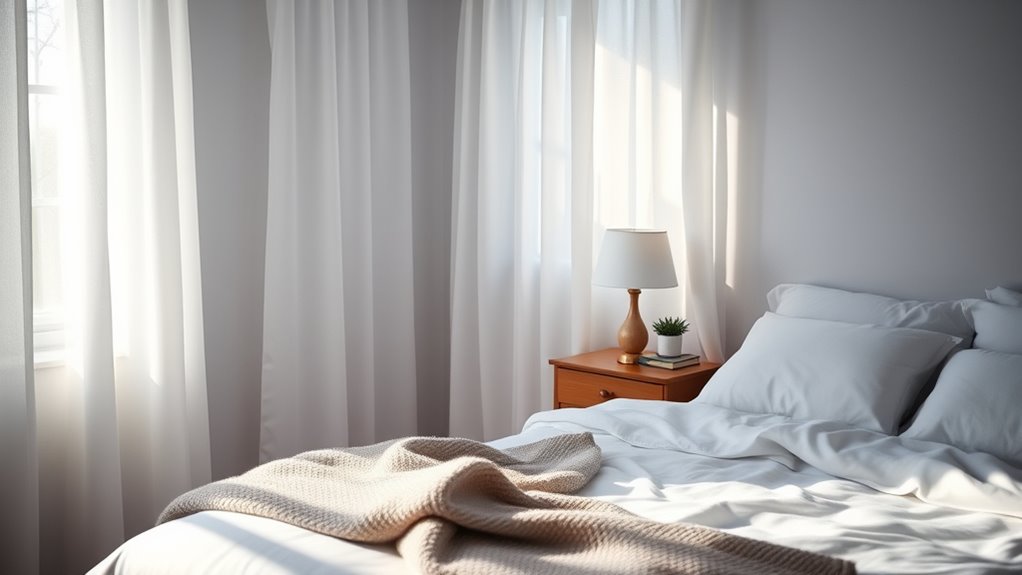To quiet a racing mind, start by decluttering your bedroom, keeping only essentials to create a peaceful space. Use blackout curtains or a sleep mask to block out light and set a calming atmosphere with dim, warm lighting. Maintain a cool, comfortable temperature and invest in supportive bedding. Establish relaxing routines, like gentle stretches or meditation, and add soothing sounds or aromatherapy. Keep exploring for more simple tweaks that can turn your space into your perfect sleep sanctuary.
Key Takeaways
- Keep the bedroom clutter-free and only essentials on the nightstand to promote calm and reduce distractions.
- Use blackout curtains, dim lighting, and avoid screens before bed to signal relaxation and boost melatonin.
- Maintain a cool, comfortable temperature and choose breathable bedding to prevent overheating.
- Incorporate soothing sounds or aromatherapy with lavender or chamomile to create a tranquil atmosphere.
- Establish consistent bedtime routines like gentle stretching and calming activities to reinforce sleep habits.

A peaceful sleep sanctuary can transform your nightly rest from restless to restorative. When your bedroom feels inviting and calm, it’s easier to let go of the day’s stress and slip into a deep, uninterrupted sleep. Small tweaks can make a big difference. Start by evaluating your bedroom environment. Remove clutter and keep only essentials on your nightstand to create a serene space. A tidy room reduces visual distractions and signals to your brain that it’s time to relax.
Creating a calm, clutter-free bedroom fosters restful, uninterrupted sleep.
Lighting plays a vital role. Switch to blackout curtains or use a sleep mask to block out external light. Dim, warm lighting in the evening helps your body produce melatonin, the hormone that promotes sleep. Avoid screens at least an hour before bed; the blue light emitted can interfere with melatonin production, making it harder to fall asleep. Instead, opt for calming activities like reading a physical book or listening to soft music. These gentle routines prepare your mind and body for rest.
Temperature is another key factor. Keep your bedroom cool—around 60 to 67 degrees Fahrenheit (15.5 to 19.5°C)—to facilitate sleep. Use fans or air conditioning if needed, but avoid excessively hot or cold environments that can disrupt your rest. Comfortable bedding also matters. Invest in a supportive mattress and pillows that suit your sleeping style. Breathable sheets made of natural fibers like cotton or linen help regulate temperature and prevent overheating during the night.
Soundproofing your space can considerably quiet your racing mind. If outside noise is an issue, consider using earplugs or a white noise machine. Gentle, consistent background noise can mask intrusive sounds and create a calming atmosphere. Aromatherapy can also be beneficial. Scents like lavender or chamomile have relaxing properties that help ease your mind. Use a diffuser or a few drops of essential oil on your pillow to enhance tranquility.
Lastly, incorporate calming rituals into your bedtime routine. Dim the lights, turn off screens, and engage in activities that calm your mind—such as deep breathing, meditation, or gentle stretching. Consistency is key; going to bed and waking up at the same time each day strengthens your body’s natural sleep-wake cycle, making it easier to drift off and stay asleep. Creating a sleep-conducive environment can significantly improve your chances of restful sleep. Small, intentional adjustments to your bedroom environment can create a sanctuary that quiets your racing mind, making restful sleep not just a goal, but a consistent reality.
Frequently Asked Questions
How Long Does It Typically Take to See Improvements After Bedroom Adjustments?
You might notice improvements in your sleep within a few nights to a week after making bedroom adjustments. Creating a calming environment, like dimming lights, reducing noise, and removing distractions, helps your mind relax faster. Consistency is key, so sticking to these changes daily accelerates results. Keep track of your sleep quality, and you’ll likely see a calmer mind and better rest sooner than you expect.
Are There Specific Colors That Promote Better Sleep?
You should opt for calming colors like soft blue, gentle green, or warm neutrals, as they promote relaxation and reduce stress. These hues help create a tranquil environment that signals your brain it’s time to wind down. Avoid bright or overly stimulating colors like red or neon shades, which can increase alertness. By choosing soothing colors, you’ll enhance your chances of falling asleep faster and enjoying more restful nights.
Can Certain Scents Help Calm a Restless Mind at Night?
Imagine your mind as a stormy sky, and certain scents as gentle breezes that calm the turbulence. Lavender, chamomile, and ylang-ylang act like soft winds, easing your thoughts and encouraging relaxation. You can diffuse these essential oils or add them to a pillow or bath, allowing their soothing aroma to settle your restless mind. These natural scents help create a tranquil atmosphere, guiding you gently into restful sleep.
What Are the Best Sleep Positions for Relaxing the Brain?
You should sleep on your back with a supportive pillow, as it keeps your spine aligned and reduces pressure points, helping your brain relax. Alternatively, sleeping on your side, especially with a pillow between your knees, promotes better circulation and eases tension. Avoid sleeping on your stomach, which can strain your neck and disrupt restful brain activity. Experiment to find the position that helps your mind unwind most effectively.
How Does Technology Use Before Bed Affect Sleep Quality?
Technology tricks your brain into staying alert, sabotaging your sleep. When you scroll, surf, or stream before bed, bright screens emit blue light that suppresses melatonin, making it harder to wind down. This delay in drowsiness leads to restless, reduced sleep quality. To improve your rest, ditch devices at least an hour before bedtime, switch to soothing activities, and create a calm, cool, and dark sleep space.
Conclusion
Think of your bedroom as a peaceful harbor, where your racing mind can finally anchor and rest. With gentle tweaks—calming lights, soothing scents, and clutter-free space—you create a safe haven from stormy thoughts. When you nurture this sanctuary, sleep becomes a gentle tide that washes away worries, leaving you refreshed and ready to face a new day. Your bedroom is your personal harbor—peaceful, secure, and waiting to cradle you into restful sleep.









